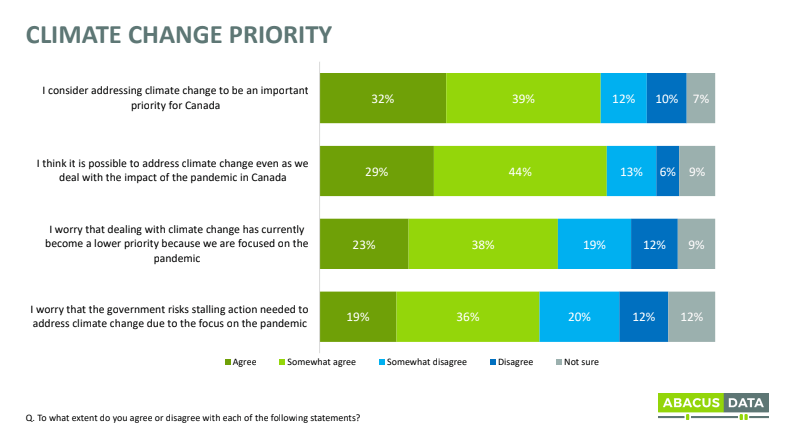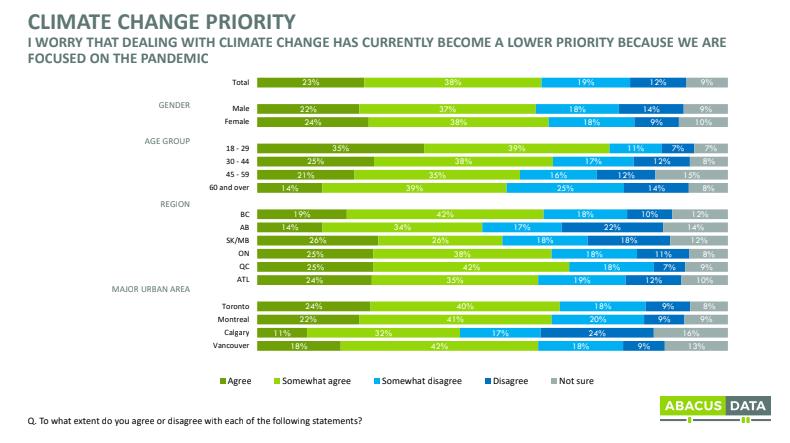Clean Electricity—Key to Canada’s Climate Targets
Patrick Bateman, Francis Bradley, Michelle Branigan, John Gorman, Robert Hornung, and Elisa Obermann
May 12, 2021
Even as we navigate the pandemic, a new poll shows that most Canadians remain concerned about climate change – and they want clean electricity to be part of the solution.
Specifically, the poll by Abacus Data reveals that 94 percent of Canadians agree that transitioning to clean electricity – such as hydro, nuclear, wind, solar, biomass and marine energy resources – is key to climate action..
Abacus reports that 56 percent of Canadians “think a significant investment in clean energy sources should be made to replace fossil fuels with clean electricity in order to reach our net-zero emissions goals” by 2050.
The Abacus online survey of 2,000 Canadians, conducted March 12-17, found that “a large majority of Canadians,” 71 percent, “consider addressing climate change to be an important priority” although 61 percent acknowledged it might be treated as a “lower priority because of the pandemic.”
Electricity can lead the way to a clean energy future and help combat the climate crisis. Canada’s national electricity associations are on it. Here’s how.
Canada’s electricity sector has already reached and exceeded our Paris Agreement target of reducing GHG emissions 30 percent below 2005 levels by 2030, the so-called 30/30 goal. In 2019, emissions from electricity generation had been cut almost in half from 2005 levels. That’s a major success story, with more on the way.
As the coal era in Canada comes to an end in the coming years, emissions will be reduced further. Soon, Canada will be one of the few countries in the world approaching 90 percent of our grid powered by non-emitting sources. The federal government has made a commitment to achieve a net-zero greenhouse gas emissions electricity grid before 2050, and Canada is well positioned to meet this target in an expedited manner.
Beyond a clean grid, however, electricity has much more to give to support Canada’s economy and climate change objectives.

As the leading suppliers of electricity to consumers and markets, we all agree on two things that can position electricity to play a leadership role, regardless of electricity generation source, recognizing that Canada has many existing and potential non-emitting renewables, nuclear and fossil fuel energy resources.
First, comprehensive strategies are required to grow non-emitting electricity demand in sectors that have traditionally relied on carbon-based fuels—including transportation, industry, and infrastructure.
You may have heard the buzz about “electrification” if someone you know is considering an electric vehicle. Perhaps you have read about the production of hydrogen fuel from electrolysis. Innovation is transforming every heavy polluting sector including freight, steel making, and aluminum smelting. New possibilities for electrification that once seemed impossible are now within reach. Numerous studies envision Canada’s demand for non-electricity doubling or tripling as we move to net-zero greenhouse gas emissions across the economy by 2050.
Second, infrastructure investments are critical. All electricity sources rely on wires to travel short or long distances from source to demand. Our massive electric system, that has been built over more than a century, must continue to be modernized to improve the efficiency of harnessing our abundant energy resources. Expanding and strengthening our grids, modernizing them by incorporating new technologies on both the supply and demand side to improve their efficiency, and improving their resilience to extreme weather events is essential to enable a future where electricity plays a central role in our energy supply.

The construction of new electricity infrastructure, coupled with the deployment of new energy efficiency, non-emitting generation and electrification technologies, will create tens of thousands of jobs. It will also mean tremendous changes to Canada’s labour market. Workers will need different skill sets and new knowledge to leverage new technologies and processes. That will mean new education pathways, upskilling and reskilling of current workers, and an ample workforce.
Canada can—and must—prioritize using our abundant, established, and emerging electricity resources to accelerate our climate progress and decarbonize our country. Canadians want to use clean electricity to meet their energy needs, and they want government to support and enable citizens to be part of protecting our climate. We must start now to rapidly deploy existing technologies, train the workforce for the jobs, develop nascent technologies, and connect all the components in a more integrated manner across our national grid.
As we plan for COP26 on the heels of the first Leaders Summit on Climate on Earth Day, one of the key themes global leaders must consider is how to galvanize efforts by the world’s major economies to reduce emissions during this critical decade.
Let’s not waste any more time putting the necessary pieces in place to realize full decarbonizing potential of the non-emitting electricity sector, while we still have the time to do so. With the right policies and support, electricity can continue to be Canada’s leading climate solution.
Patrick Bateman is Interim President, WaterPower Canada; Francis Bradley is President and CEO of the Canadian Electricity Association; Michelle Branigan is CEO of Electricity Human Resources Canada; John Gorman is President and CEO of the Canadian Nuclear Association; Robert Hornung is President and CEO of the Canadian Renewable Energy Association; Elisa Obermann is Executive Director of Marine Renewables Canada.
